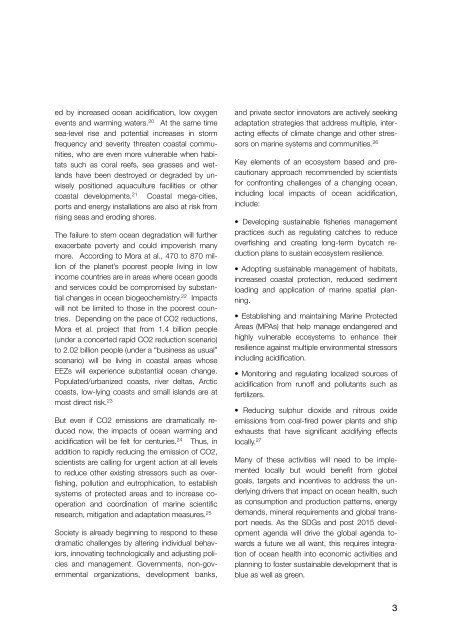IUCN Policy Brief Oceans SDGs Jan
IUCN Policy Brief Oceans SDGs Jan
IUCN Policy Brief Oceans SDGs Jan
You also want an ePaper? Increase the reach of your titles
YUMPU automatically turns print PDFs into web optimized ePapers that Google loves.
ed by increased ocean acidification, low oxygen<br />
events and warming waters.<br />
20<br />
At the same time<br />
sea-level rise and potential increases in storm<br />
frequency and severity threaten coastal communities,<br />
who are even more vulnerable when habitats<br />
such as coral reefs, sea grasses and wetlands<br />
have been destroyed or degraded by unwisely<br />
positioned aquaculture facilities or other<br />
coastal developments.<br />
21<br />
Coastal mega-cities,<br />
ports and energy installations are also at risk from<br />
rising seas and eroding shores.<br />
The failure to stem ocean degradation will further<br />
exacerbate poverty and could impoverish many<br />
more. According to Mora at al., 470 to 870 million<br />
of the planet’s poorest people living in low<br />
income countries are in areas where ocean goods<br />
and services could be compromised by substantial<br />
changes in ocean biogeochemistry.<br />
22<br />
Impacts<br />
will not be limited to those in the poorest countries.<br />
Depending on the pace of CO2 reductions,<br />
Mora et al. project that from 1.4 billion people<br />
(under a concerted rapid CO2 reduction scenario)<br />
to 2.02 billion people (under a “business as usual”<br />
scenario) will be living in coastal areas whose<br />
EEZs will experience substantial ocean change.<br />
Populated/urbanized coasts, river deltas, Arctic<br />
coasts, low-lying coasts and small islands are at<br />
most direct risk.<br />
23<br />
But even if CO2 emissions are dramatically reduced<br />
now, the impacts of ocean warming and<br />
acidification will be felt for centuries.<br />
24<br />
Thus, in<br />
addition to rapidly reducing the emission of CO2,<br />
scientists are calling for urgent action at all levels<br />
to reduce other existing stressors such as overfishing,<br />
pollution and eutrophication, to establish<br />
systems of protected areas and to increase cooperation<br />
and coordination of marine scientific<br />
research, mitigation and adaptation measures.<br />
25<br />
Society is already beginning to respond to these<br />
dramatic challenges by altering individual behaviors,<br />
innovating technologically and adjusting policies<br />
and management. Governments, non-governmental<br />
organizations, development banks,<br />
and private sector innovators are actively seeking<br />
adaptation strategies that address multiple, interacting<br />
effects of climate change and other stressors<br />
on marine systems and communities.<br />
26<br />
Key elements of an ecosystem based and precautionary<br />
approach recommended by scientists<br />
for confronting challenges of a changing ocean,<br />
including local impacts of ocean acidification,<br />
include:<br />
• Developing sustainable fisheries management<br />
practices such as regulating catches to reduce<br />
overfishing and creating long-term bycatch reduction<br />
plans to sustain ecosystem resilience.<br />
• Adopting sustainable management of habitats,<br />
increased coastal protection, reduced sediment<br />
loading and application of marine spatial planning.<br />
• Establishing and maintaining Marine Protected<br />
Areas (MPAs) that help manage endangered and<br />
highly vulnerable ecosystems to enhance their<br />
resilience against multiple environmental stressors<br />
including acidification.<br />
• Monitoring and regulating localized sources of<br />
acidification from runoff and pollutants such as<br />
fertilizers.<br />
• Reducing sulphur dioxide and nitrous oxide<br />
emissions from coal-fired power plants and ship<br />
exhausts that have significant acidifying effects<br />
locally.<br />
27<br />
Many of these activities will need to be implemented<br />
locally but would benefit from global<br />
goals, targets and incentives to address the underlying<br />
drivers that impact on ocean health, such<br />
as consumption and production patterns, energy<br />
demands, mineral requirements and global transport<br />
needs. As the <strong>SDGs</strong> and post 2015 development<br />
agenda will drive the global agenda towards<br />
a future we all want, this requires integration<br />
of ocean health into economic activities and<br />
planning to foster sustainable development that is<br />
blue as well as green.<br />
3
















